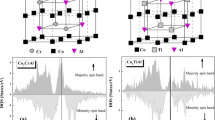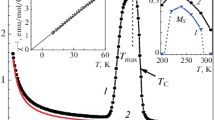Abstract
Electronic, magnetic, and structural properties of pure and V-doped CrO2 were extensively investigated utilizing density functional theory. Usually, pure CrO2 is a half-metallic ferromagnet with conductive spin majority species and insulating spin minority species. This system remains in its half-metallic ferromagnetic phase even at 50% V-substitution for Cr within the crystal. The V-substituted compound Cr0.5V0.5O2 encounters metal–insulator transition upon the application of on-site Coulomb repulsion U = 7 eV preserving its ferromagnetism in the insulating phase. It is revealed in this study that Cr3+-V5+ charge ordering accompanied by the transfer of the single V-3d electron to the Cr-3dt2g orbitals triggers metal–insulator transition in Cr0.5V0.5O2. The ferromagnetism of Cr0.5V0.5O2 in the insulating phase arises predominantly due to strong Hund’s coupling between the occupied electrons in the Cr-t2g states. Besides this, the ferromagnetic Curie temperature (Tc) decreases significantly due to V-substitution. Interestingly, a structural distortion is observed due to tilting of CrO6 or VO6 octahedra across the metal–insulator transition of Cr0.5V0.5O2.

The V-doped compound Cr0.5V0.5O2 is found a half-metallic ferromagnet (HMF) in the absence of on-site Coulomb interaction (U). This HMF behavor maintains up to U = 6 eV. Eventually, this system encounters metal-insulator transition (MIT) upon the application of U = 7 eV with a band gap of Eg ~ 0.31 eV. Nevertheless, applications of higher U widen the band gaps. In this figure, calculated total (black), Cr-3d (red), V-3d (violet), and O-2p (blue) DOS of Cr0.5V0.5O2 for U = 8 eV are illustrated. The system is insulating with a band gap of Eg ~ 0.7 eV.










Similar content being viewed by others
Change history
24 March 2023
A Correction to this paper has been published: https://doi.org/10.1007/s00894-023-05522-7
References
Daughton JM (1997) Magnetic tunnelling applied to memory (invited). J Appl Phys 81:3758
Zhu JG, Zheng Y, Prinz GA (2000) Ultrahigh density vertical magnetoresistive random access memory (invited). J Appl Phys 87:6668
Han XF, Wen ZC, Wei HX (2008) Nanoring magnetic tunnel junction and its application in magnetic random access memory demo devices with spin-polarized current switching (invited). J Appl Phys 103:07E933
Wood R (2009) Future hard disk drive systems. J Magn Magn Mater 321:555–561
Lu J, West KG, Wolf SA (2010) Thin film metal-oxides. Ed. Ramanathan S Springer (US): p 95
Schwarz K (1986) CrO2 predicted as a half-metallic ferromagnet. J Phys F: Met Phys 16(9):L211
Kämper KP, Schmitt W, Güntherodt G, Gambino RJ, Ruf R (1987) CrO2-a new half-metallic ferromagnet? Phys Rev Lett 59(24):2788
Soulen RJ, Byers Jr JM, Osofsky MS, Nadgorny B, Ambrose T, Cheng SF, Broussard PR, Tanaka CT, Nowak J, Moodera JS, Barry A, Coey JMD (1998) Measuring the spin polarization of a metal with a superconducting point contact. Science 282(5386):85–88
Anguelouch A, Gupta A, Xiao G, Abraham DW, Ji Y, Ingvarsson S, Chien CL (2001) Near-complete spin polarization in atomically-smooth chromium-dioxide epitaxial films prepared using a CVD liquid precursor. Phys Rev B 64(18):180408
Muller GM, Walowski J, Djordjevic M, Miao GX, Gupta A, Ramos AV, Gehrke K, Moshnyaga V, Samwer K, Schmalhorst J et al (2009) Spin polarization in half-metals probed by femtosecond spin excitation. Nat Mater 8:56
Anwar MS, Czeschka F, Hasselberth M, Porcu M, Aarts J (2010) Long-range supercurrents through half-metallic ferromagnetic CrO2. Phys Rev B 82:100501(R)
Anwar MS, Aarts J (2013) Anomalous transport in half-metallic ferromagnetic CrO2. Phys Rev B 88:085123
Fujiwara H, Sunagawa M, Terashima K, Kittaka T, Wakita T, Muraoka Y, Yokoya T (2015) Intrinsic spin-polarized electronic structure of CrO2 epitaxial film revealed by bulk-sensitive spin-resolved photoemission spectroscopy. Appl Phys Lett 106:202404
Takeda H, Shimizu Y, Kobayashi Y, Itoh M, Jinno T, Isobe M, Ueda Y, Yoshida S, Muraoka Y, Yokoya T (2016) Local electronic state in the half-metallic ferromagnet CrO2 investigated by site-selective 53Cr NMR measurements. Phys Rev B 93:235129
Singh A, Jansen C, Lahabi K, Aarts J (2016) High-quality CrO2 nanowires for dissipation-less spintronics. Phys Rev X 6:041012
Hohenberg P, Kohn W (1964) Inhomogeneous electron gas. Phys Rev B 136:B864
Kohn W, Sham LJ (1965) Self-consistent equations including exchange correlation effects. Phys Rev 140:A1133
Perdew JP, Wang Y (1992) Accurate and simple analytic representation of the electron gas correlation energy. Phys Rev B 45:13244
Anderson OK, Jepsen O (1984) Explicit, first-principles tight-binding theory. Phys Rev Lett 53:2571
Anderson OK (1975) Linear methods in band theory. Phys Rev B 12:3060
Coey JMD, Venkatesan M (2002) Half-metallic ferromagnetism: example of CrO2 (invited). J Appl Phys 91(10):8345–8350
Shirley DA, Martin RL, Kowalczyk SP, McFeely FR, Ley L (1977) Core-electron binding energies of the first thirty elements. Phys Rev B 15:544
Harry G (1964) Electrons and chemical bonding. Benjamin, New York
Piper LFJ, DeMasi A, Cho SW, Preston ARH, Laverock J, Smith KE, West KG, Lu JW, Wolf SA (2010) Soft x-ray spectroscopic study of the ferromagnetic insulator V0.82Cr0.18O2. Phys Rev B 82(23):235103
Williams ME, Sims H, Mazumdar D, Butler WH (2012) Effects of 3d and 4d transition metal substitutional impurities on electronic properties of CrO2. Phys Rev B 86:235124
Stoner EC (1936) Collective electron specific heat and spin paramagnetism in metals. Proc R Soc A 154:656
Stoner EC (1938) Collective electron ferromagnetism. Proc R Soc Lond A 165:372
Moriya T, Kawabata A (1973) Effect of spin fluctuations on itinerant electron ferromagnetism. J Phys Soc Jpn 34:639
Suzuki K, Masuda Y (1985) Thermal expansion in itinerant electron magnetic Ni Al system. J Phys Soc Jpn 54:630
Author information
Authors and Affiliations
Corresponding author
Rights and permissions
About this article
Cite this article
Biswas, S. Charge ordering in the metal–insulator transition of V-doped CrO2 in the rutile structure. J Mol Model 24, 111 (2018). https://doi.org/10.1007/s00894-018-3647-2
Received:
Accepted:
Published:
DOI: https://doi.org/10.1007/s00894-018-3647-2




